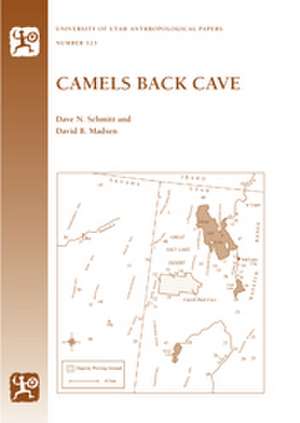Camels Back Cave: Anthropological Paper 125: University of Utah Anthropological Paper, cartea 125
Autor Dave N. Schmitt, David B. Madsenen Limba Engleză Paperback – 31 oct 2005 – vârsta ani
University of Utah Anthropological Paper No. 125
Camels Back Cave is in an isolated limestone ridge on the southern edge of the Great Salt Lake Desert. Recent archaeological investigations there have exposed a series of stratified deposits spanning the entire Holocene era (10,000 BP–present), deposits that show intermittent human occupations dating back through the past 7,600 years. Most human visits to the cave were brief—many likely representing overnight stays—and visitors did not dig pits or move sediment. As a result, fieldworkers were able to recognize and remove thirty-three stratigraphic horizons; radiocarbon analysis provided a pristine, high-resolution chronological sequence of human use. The brevity of visits and the undisturbed nature of the deposits also allowed researchers to identify portions of eight “living surfaces” where they exposed and mapped artifacts and ecofacts across contiguous blocks of units.
Aside from presenting model field techniques, this volume provides new and unique information on regional Holocene climates and biotic communities, cave taphonomy and small mammal hunting, as well as updated human chronologies for Great Basin occupation.
Camels Back Cave is in an isolated limestone ridge on the southern edge of the Great Salt Lake Desert. Recent archaeological investigations there have exposed a series of stratified deposits spanning the entire Holocene era (10,000 BP–present), deposits that show intermittent human occupations dating back through the past 7,600 years. Most human visits to the cave were brief—many likely representing overnight stays—and visitors did not dig pits or move sediment. As a result, fieldworkers were able to recognize and remove thirty-three stratigraphic horizons; radiocarbon analysis provided a pristine, high-resolution chronological sequence of human use. The brevity of visits and the undisturbed nature of the deposits also allowed researchers to identify portions of eight “living surfaces” where they exposed and mapped artifacts and ecofacts across contiguous blocks of units.
Aside from presenting model field techniques, this volume provides new and unique information on regional Holocene climates and biotic communities, cave taphonomy and small mammal hunting, as well as updated human chronologies for Great Basin occupation.
Preț: 327.77 lei
Preț vechi: 378.16 lei
-13% Nou
Puncte Express: 492
Preț estimativ în valută:
62.72€ • 65.97$ • 52.41£
62.72€ • 65.97$ • 52.41£
Carte indisponibilă temporar
Doresc să fiu notificat când acest titlu va fi disponibil:
Se trimite...
Preluare comenzi: 021 569.72.76
Specificații
ISBN-13: 9780874808414
ISBN-10: 0874808413
Pagini: 312
Ilustrații: 112 illustrations
Dimensiuni: 216 x 279 x 20 mm
Greutate: 0.83 kg
Ediția:1st Edition
Editura: University of Utah Press
Colecția University of Utah Press
Seria University of Utah Anthropological Paper
ISBN-10: 0874808413
Pagini: 312
Ilustrații: 112 illustrations
Dimensiuni: 216 x 279 x 20 mm
Greutate: 0.83 kg
Ediția:1st Edition
Editura: University of Utah Press
Colecția University of Utah Press
Seria University of Utah Anthropological Paper
Recenzii
"A model of field research and reporting"—Joel Janetski, Brigham Young University
"An important contribution to the archaeology of the greater region."—Matthew Seddon, SWCA Environmental Consultants
Notă biografică
Dave Schmitt is a research associate with the department of anthropology at Washington State University and part-time archaeologist with the Desert Research Institute. He is coauthor of Buzz-Cut Dune and Fremont Foraging at the Margin of Horticulture, University of Utah Anthropological Papers Number 124 (University of Utah Press, 2005).
David Madsen is an archaeologist with Texas Archaeological Research Laboratory. He is the author of Entering America: Northeast Asia and Beringia before the Last Glacial Maximum (University of Utah Press, 2004) and coauthor of Buzz-Cut Dune and Fremont Foraging at the Margin of Horticulture, University of Utah Anthropological Papers Number 124 (University of Utah Press, 2005).
David Madsen is an archaeologist with Texas Archaeological Research Laboratory. He is the author of Entering America: Northeast Asia and Beringia before the Last Glacial Maximum (University of Utah Press, 2004) and coauthor of Buzz-Cut Dune and Fremont Foraging at the Margin of Horticulture, University of Utah Anthropological Papers Number 124 (University of Utah Press, 2005).
Descriere
Covers an isolated limestone ridge on the southern edge of the Great Salt Lake Desert, where archaeologists have exposed a series of stratified deposits spanning the entire Holocene era.











